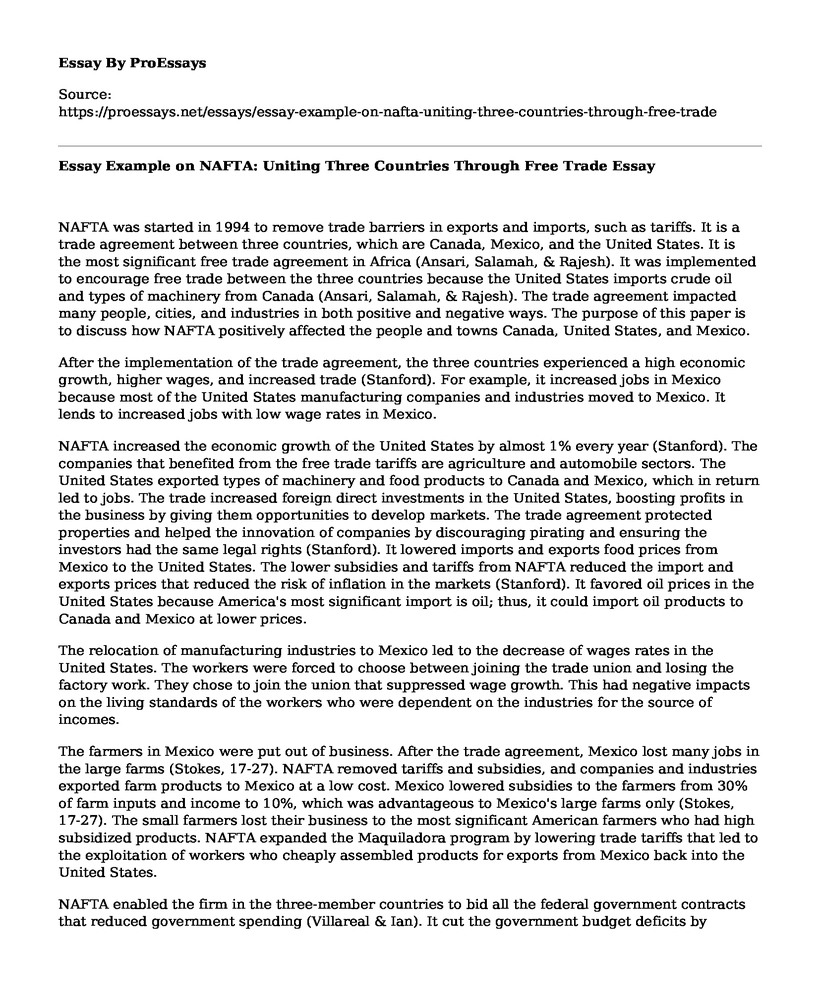NAFTA was started in 1994 to remove trade barriers in exports and imports, such as tariffs. It is a trade agreement between three countries, which are Canada, Mexico, and the United States. It is the most significant free trade agreement in Africa (Ansari, Salamah, & Rajesh). It was implemented to encourage free trade between the three countries because the United States imports crude oil and types of machinery from Canada (Ansari, Salamah, & Rajesh). The trade agreement impacted many people, cities, and industries in both positive and negative ways. The purpose of this paper is to discuss how NAFTA positively affected the people and towns Canada, United States, and Mexico.
After the implementation of the trade agreement, the three countries experienced a high economic growth, higher wages, and increased trade (Stanford). For example, it increased jobs in Mexico because most of the United States manufacturing companies and industries moved to Mexico. It lends to increased jobs with low wage rates in Mexico.
NAFTA increased the economic growth of the United States by almost 1% every year (Stanford). The companies that benefited from the free trade tariffs are agriculture and automobile sectors. The United States exported types of machinery and food products to Canada and Mexico, which in return led to jobs. The trade increased foreign direct investments in the United States, boosting profits in the business by giving them opportunities to develop markets. The trade agreement protected properties and helped the innovation of companies by discouraging pirating and ensuring the investors had the same legal rights (Stanford). It lowered imports and exports food prices from Mexico to the United States. The lower subsidies and tariffs from NAFTA reduced the import and exports prices that reduced the risk of inflation in the markets (Stanford). It favored oil prices in the United States because America's most significant import is oil; thus, it could import oil products to Canada and Mexico at lower prices.
The relocation of manufacturing industries to Mexico led to the decrease of wages rates in the United States. The workers were forced to choose between joining the trade union and losing the factory work. They chose to join the union that suppressed wage growth. This had negative impacts on the living standards of the workers who were dependent on the industries for the source of incomes.
The farmers in Mexico were put out of business. After the trade agreement, Mexico lost many jobs in the large farms (Stokes, 17-27). NAFTA removed tariffs and subsidies, and companies and industries exported farm products to Mexico at a low cost. Mexico lowered subsidies to the farmers from 30% of farm inputs and income to 10%, which was advantageous to Mexico's large farms only (Stokes, 17-27). The small farmers lost their business to the most significant American farmers who had high subsidized products. NAFTA expanded the Maquiladora program by lowering trade tariffs that led to the exploitation of workers who cheaply assembled products for exports from Mexico back into the United States.
NAFTA enabled the firm in the three-member countries to bid all the federal government contracts that reduced government spending (Villareal & Ian). It cut the government budget deficits by enhancing more competition and small-cost bids, which enhanced government saving that promotes development in the three-member countries.
Conclusion
In conclusion, NAFTA had benefits and problems for the people, the economy of the member countries, and the government. The trade had negative impacts on the people because it led to the loss of jobs in the United States; the workers faced exploitation where the packed exports at a lower salary. It leads to a loss of wage rates. NAFTA led to economic growth, lowered imports prices, reduced government trade spending, increased investments, and increased trade. It enabled the three member countries to export and import products at lower tariffs.
References
Ansari, Salamah, and R. Rajesh Babu. "5. North American Free Trade Agreement (NAFTA)." Yearbook of International Environmental Law (2020). https://academic.oup.com/yielaw/advance-article-abstract/doi/10.1093/yiel/yvz032/5700403
Stanford, Jim. "North American free trade: history, structure, and prospects." The Handbook of Globalisation, Third Edition. Edward Elgar Publishing, 2019. https://www.elgaronline.com/view/edcoll/9781788118590/9781788118590.00026.xml
Stokes, Shyla. "The North American Free Trade Agreement (NAFTA): Potential Changes, Effects, and What to Do Concerning the Trucking Industry." Undergraduate Review 14.2 (2018): 17-27. https://vc.bridgew.edu/undergrad_rev/vol14/iss2/6/
Villareal, M., and Ian F. Fergusson. "The North American Free Trade Agreement (NAFTA)." (2017).https://digitalcommons.ilr.cornell.edu/key_workplace/1937/
Cite this page
Essay Example on NAFTA: Uniting Three Countries Through Free Trade. (2023, May 08). Retrieved from https://proessays.net/essays/essay-example-on-nafta-uniting-three-countries-through-free-trade
If you are the original author of this essay and no longer wish to have it published on the ProEssays website, please click below to request its removal:
- Retailing and the Change the Business Is Encountering Essay
- IKEA: Making Life Better for the World's Many People Essay
- Local Content in Petroleum Producing Economies Paper Example
- How USA Do Business With Other Countries Paper Example
- Essay Sample on South China Sea Dispute: Multilateral Conflict Over Resources
- Essay Example on US-China Trade War: Top Leaders' Phone Call to Resume Negotiations
- Labor Formation Comparison: Germany vs USA - Free Essay Sample







